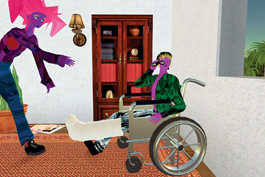home | metro silicon valley index | the arts | visual arts | review

Courtesy of the artist
REMAKE: Scott Kildall's 'Window' harks all the way back to Hitchcock's 'Rear Window.'
Media Massaging
The artists in de Saisset's 'Tech Tools of the Trade' experiment with the possibilities of new media
By Michael S. Gant
IN THE quickening rapids of technology, "new" is a relative term. What seemed cutting edge just a few years ago can suddenly appear as quaint as hand embroidery. Case in point: Ben Rubin and Mark Hansen's Listening Post installation at the San Jose Museum of Art brilliantly took the streaming memes of Internet chatter and turned them into flowing illuminated words on a dangling curtain of tiny video screens. That was just three years ago, and now the effect is pretty much available on any computer courtesy of TweetDeck.
"Tech Tools of the Trade," a group show at the de Saisset Musuem at Santa Clara University, ranges widely in its presentation of media-driven works by Bay Area artists. Alan Rath's New Watcher IX looks positively classical, even though it's dated 2005. Two round metal circles connected to metal arms in a V-shape contain tiny video monitors that project a pair of eyes. Such technical minimalism is enough to suggest a sculpture of an uncanny being on the verge of consciousness.
More au courant, simply because we all spend too much time web surfing, is Anthony Discenza's Dream Home (2007). Taking the search words of the title, Discenza has assembled the visual results and edited them together into an ever-changing metahouse that ceaselessly morphs, one rectangular section at a time, in an unfolding dance of architectural desiderata. Depressingly, the ideal abode turns out to be nothing more than a soulless McMansion with ersatz columns. The piece takes on added irony given the spectacular burst of the housing bubble.
Jill Miller's two-channel video Les Grandes Odalisques (2004) resonates beautifully with its source, Ingres' famous painting of the backside of a languorous nude courtesan turning her head to implicate us with her glance. On two screens, Miller projects modern persons replicating the pose, stretched out on their beds, propped up on one elbow. The bodies depicted range from sleek to lumpy—one model could have stepped out of a Francis Bacon painting. There is both a stillness and a crucial narrative at work: at some point, after a minute or so, each model swivels around to stare us down with a disarming look that asks, "What are you looking at?"
Less successful is Nina Katchadourian's Accent Elimination (2005), a video projection on three TV sets in which the artist and her parents, in an overlapping verbal roundelay, argue about how their accents might converge. The cacophony overwhelms the didactic message about assimilation, and the artist comes off as a scold.
Several artists comment on the two-way nature of technology; all of that access means that someone is probably watching back, keeping an eye on us. Martha Gorzycki makes the specter of surveillance literal in Veil (2002), a projected wall image of a large pair of darting eyes overlaid with a grid of many smaller, equally probing eyes. Are these Big Brother's minions keeping an eye on us—or are they reflections of our own nervous, sideway glances, as we wonder who's watching?
Sherry Karver zeroes in on airport security, the last bastion of Homeland Security paranoia. In Big Bomb (2007), she converts old suitcases into light boxes displaying jumbles of flotsam, any of which (from an innocent liquid-filled bottle to a can't-miss bundle of dynamite) could be dangerous.
In a strange exercise in art-history navel-gazing, Scott Kildall uses Second Life to re-create famous performance-art happenings, such as Yoko Ono's Cut, Yves Klein's Leap Into the Void and Chris Burden's Shoot. Scenes from the virtual productions are displayed as colorful prints populated with those gangly chunky avatars of Second Life. The most recursive of all is Window, which replicates Pierre Huyghe's Remake, in which amateur actors staged Hitchcock's Rear Window (2007). This is the new media feeding on the old, like the proverbial snake devouring itself.
TECH TOOLS OF THE TRADE: CONTEMPORARY NEW MEDIA ART runs through June 28 at the de Saisset Museum, Santa Clara University, 500 El Camino Real, Santa Clara. Open Tuesday–Sunday, 11am–4pm. Free. (408.554.4528)
Send a letter to the editor about this story.
|
|
|
|
|
|